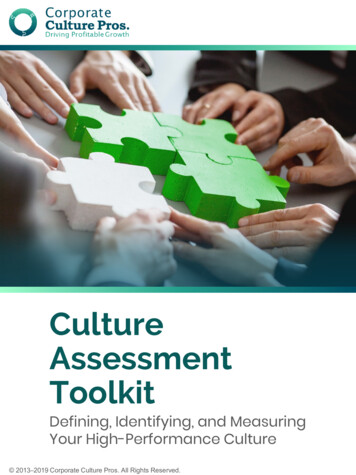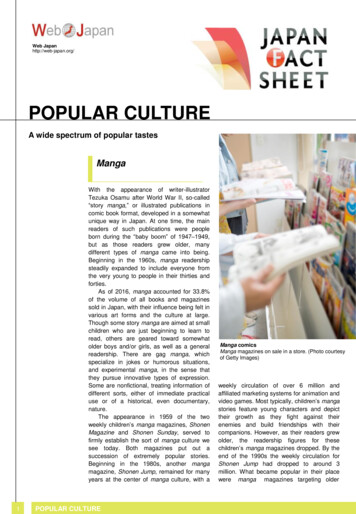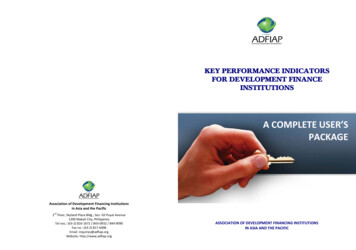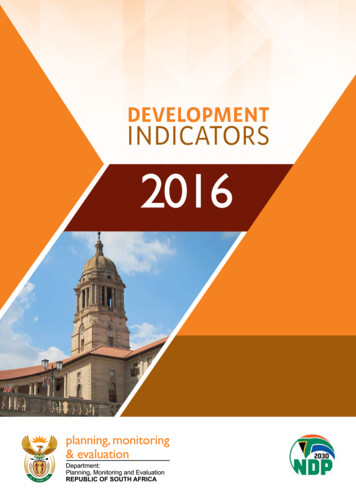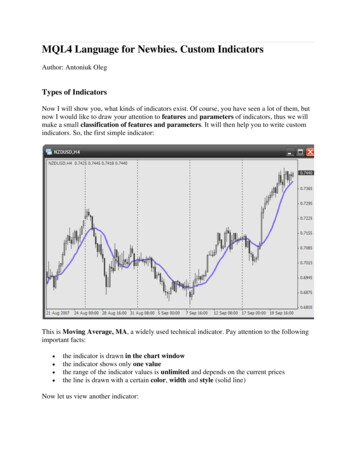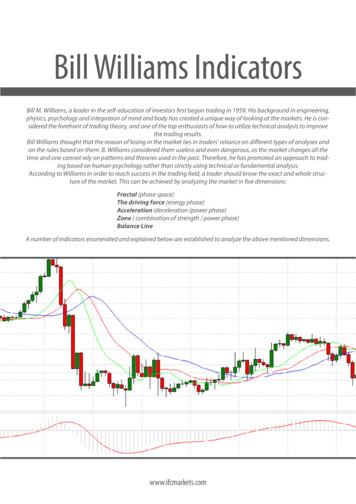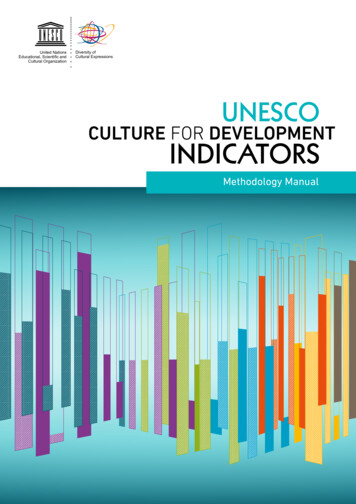
Transcription
United NationsEducational, Scientific andCultural OrganizationDiversity ofCultural ExpressionsUNESCOCULTURE FOR DEVELOPMENTINDICATORSMethodology Manual
United NationsEducational, Scientific andCultural OrganizationDiversity ofCultural ExpressionsPublished in 2014 by the United Nations Educational, Scientific and Cultural Organization7, place de Fontenoy, 75352 Paris 07 SP, France UNESCO 2014ISBN 978-92-3-001227-4This publication is available in Open Access under the Attribution-ShareAlike 3.0 IGO (CC-BY-SA 3.0 IGO) 3.0/igo/). By using the content of this publication, the users accept to bebound by the terms of use of the UNESCO Open Access Repository he designations employed and the presentation of material throughout this publication do not imply the expression ofany opinion whatsoever on the part of UNESCO concerning the legal status of any country, territory, city or area or of itsauthorities, or concerning the delimitation of its frontiers or boundaries.The ideas and opinions expressed in this publication are those of the authors; they are not necessarily those of UNESCOand do not commit the Organization.Cover and Graphic design: MH DesignIllustrations and Typeset: MH DesignCoordination and Project Management: Guiomar Alonso and Melika MediciWriting and Editing: Guiomar Alonso and Melika Medici with assistance from Keiko Nowacka, Guillaume Cohen and MollySteinlageFunded by: AECIDTypeset: MH DesignPrinted by: UNESCOPrinted in FranceThe UNESCO Culture for Development Indicators: Methodology Manual has benefited from technical papers andcontributions from the following experts: Lorna and George Abungu, Yvonne Donders, Simon Ellis, Omar Lopez, ChristopherMadden, Adolfo Morrone, Andrew Puddephatt, David Throsby, and Alan Wagner.The UNESCO Culture for Development Indicators: Methodology Manual can be downloaded at:www.unesco.org/creativity/cdis
METHODOLOGY MANUALTABLE OF CONTENTSForeword. . . . . . . . . . . . . . . . . . . . . . . . . . . . . . . . . . . . . . . . . . . . . . . . . . . . . . . . . . . . . . . . . . . . . . . . . . . . . . . . . . . . . . . . . . . . 3Introduction. . . . . . . . . . . . . . . . . . . . . . . . . . . . . . . . . . . . . . . . . . . . . . . . . . . . . . . . . . . . . . . . . . . . . . . . . . . . . . . . . . . . . . . . . 5Acknowledgments. . . . . . . . . . . . . . . . . . . . . . . . . . . . . . . . . . . . . . . . . . . . . . . . . . . . . . . . . . . . . . . . . . . . . . . . . . . . . . . . . . . . 7OVERVIEW . . . . . . . . . . . . . . . . . . . . . . . . . . . . . . . . . . . . . . . . . . . . . . . . . . . . . . . . . . . . . . . . . . . . . . . . . . . . . . . . . . . . . . 9ECONOMY DIMENSION. . . . . . . . . . . . . . . . . . . . . . . . . . . . . . . . . . . . . . . . . . . . . . . . . . . . . . . . . . . . . . . . 19I.RELEVANCE OF THE DIMENSION FOR CULTURE AND DEVELOPMENT. . . . . . . . . . . . . . . . . . . . . . . . . . . . . . . . 20II.DEFINITIONS . . . . . . . . . . . . . . . . . . . . . . . . . . . . . . . . . . . . . . . . . . . . . . . . . . . . . . . . . . . . . . . . . . . . . . . . . . . . . . . . . . 21III.DATA SOURCES. . . . . . . . . . . . . . . . . . . . . . . . . . . . . . . . . . . . . . . . . . . . . . . . . . . . . . . . . . . . . . . . . . . . . . . . . . . . . . . . 22IV.STEP-BY-STEP APPROACH TO IDENTIFY CULTURE IN NATIONAL ACTIVITY, OCCUPATION ANDCONSUMPTION CLASSIFICATIONS. . . . . . . . . . . . . . . . . . . . . . . . . . . . . . . . . . . . . . . . . . . . . . . . . . . . . . . . . . . . . . . . 23V.CORE INDICATORS. . . . . . . . . . . . . . . . . . . . . . . . . . . . . . . . . . . . . . . . . . . . . . . . . . . . . . . . . . . . . . . . . . . . . . . . . . . . . . 241.Contribution of cultural activities to GDP . . . . . . . . . . . . . . . . . . . . . . . . . . . . . . . . . . . . . . . . . . . . . . . . . . . . . . 242.Cultural employment . . . . . . . . . . . . . . . . . . . . . . . . . . . . . . . . . . . . . . . . . . . . . . . . . . . . . . . . . . . . . . . . . . . . . 283.Household expenditures on culture . . . . . . . . . . . . . . . . . . . . . . . . . . . . . . . . . . . . . . . . . . . . . . . . . . . . . . . . . . 31APPENDIX I TO VI . . . . . . . . . . . . . . . . . . . . . . . . . . . . . . . . . . . . . . . . . . . . . . . . . . . . . . . . . . . . . . . . . . . . . . . . . . . . . . . 35EDUCATION DIMENSION. . . . . . . . . . . . . . . . . . . . . . . . . . . . . . . . . . . . . . . . . . . . . . . . . . . . . . . . . . . . . . . 45I.RELEVANCE OF THE DIMENSION FOR CULTURE AND DEVELOPMENT. . . . . . . . . . . . . . . . . . . . . . . . . . . . . . . . . 46II.CORE INDICATORS. . . . . . . . . . . . . . . . . . . . . . . . . . . . . . . . . . . . . . . . . . . . . . . . . . . . . . . . . . . . . . . . . . . . . . . . . . . . . . 471.Inclusive education. . . . . . . . . . . . . . . . . . . . . . . . . . . . . . . . . . . . . . . . . . . . . . . . . . . . . . . . . . . . . . . . . . . . . . . 472.Multilingual education . . . . . . . . . . . . . . . . . . . . . . . . . . . . . . . . . . . . . . . . . . . . . . . . . . . . . . . . . . . . . . . . . . . . 493.Arts education . . . . . . . . . . . . . . . . . . . . . . . . . . . . . . . . . . . . . . . . . . . . . . . . . . . . . . . . . . . . . . . . . . . . . . . . . . 534.Professional training in the culture sector. . . . . . . . . . . . . . . . . . . . . . . . . . . . . . . . . . . . . . . . . . . . . . . . . . . . . 56GOVERNANCE DIMENSION . . . . . . . . . . . . . . . . . . . . . . . . . . . . . . . . . . . . . . . . . . . . . . . . . . . . . . . . . . . . 61I.RELEVANCE OF THE DIMENSION FOR CULTURE AND DEVELOPMENT. . . . . . . . . . . . . . . . . . . . . . . . . . . . . . . . . 62II.DATA SOURCES . . . . . . . . . . . . . . . . . . . . . . . . . . . . . . . . . . . . . . . . . . . . . . . . . . . . . . . . . . . . . . . . . . . . . . . . . . . . . . . . 62III.CORE INDICATORS . . . . . . . . . . . . . . . . . . . . . . . . . . . . . . . . . . . . . . . . . . . . . . . . . . . . . . . . . . . . . . . . . . . . . . . . . . . . . 631.Standard setting framework for culture. . . . . . . . . . . . . . . . . . . . . . . . . . . . . . . . . . . . . . . . . . . . . . . . . . . . . . . 632.Policy and institutional framework for culture. . . . . . . . . . . . . . . . . . . . . . . . . . . . . . . . . . . . . . . . . . . . . . . . . . 673.Distribution of cultural infrastructures . . . . . . . . . . . . . . . . . . . . . . . . . . . . . . . . . . . . . . . . . . . . . . . . . . . . . . . 704.Civil society participation in cultural governance. . . . . . . . . . . . . . . . . . . . . . . . . . . . . . . . . . . . . . . . . . . . . . . . 74
UNESCO CULTURE FOR DEVELOPMENT INDICATORSSOCIAL PARTICIPATION DIMENSION. . . . . . . . . . . . . . . . . . . . . . . . . . . . . . . . . . . . . . . . . . . . . . . . . . . . 81I.RELEVANCE OF THE DIMENSION FOR CULTURE AND DEVELOPMENT. . . . . . . . . . . . . . . . . . . . . . . . . . . . . . . . . 82II.DATA SOURCES . . . . . . . . . . . . . . . . . . . . . . . . . . . . . . . . . . . . . . . . . . . . . . . . . . . . . . . . . . . . . . . . . . . . . . . . . . . . . . . . 82III.CORE INDICATORS. . . . . . . . . . . . . . . . . . . . . . . . . . . . . . . . . . . . . . . . . . . . . . . . . . . . . . . . . . . . . . . . . . . . . . . . . . . . . . 831.Participation in going-out cultural activities. . . . . . . . . . . . . . . . . . . . . . . . . . . . . . . . . . . . . . . . . . . . . . . . . . . . 832.Participation in identity-building cultural activities . . . . . . . . . . . . . . . . . . . . . . . . . . . . . . . . . . . . . . . . . . . . . . 833.Tolerance of other cultures . . . . . . . . . . . . . . . . . . . . . . . . . . . . . . . . . . . . . . . . . . . . . . . . . . . . . . . . . . . . . . . . 884.Interpersonal trust. . . . . . . . . . . . . . . . . . . . . . . . . . . . . . . . . . . . . . . . . . . . . . . . . . . . . . . . . . . . . . . . . . . . . . . 905.Freedom of self-determination . . . . . . . . . . . . . . . . . . . . . . . . . . . . . . . . . . . . . . . . . . . . . . . . . . . . . . . . . . . . . 92APPENDIX I TO II. . . . . . . . . . . . . . . . . . . . . . . . . . . . . . . . . . . . . . . . . . . . . . . . . . . . . . . . . . . . . . . . . . . . . . . . . . . . . . . . . . . . . 97GENDER EQUALITY DIMENSION. . . . . . . . . . . . . . . . . . . . . . . . . . . . . . . . . . . . . . . . . . . . . . . . . . . . . . . 101I.RELEVANCE OF THE DIMENSION FOR CULTURE AND DEVELOPMENT. . . . . . . . . . . . . . . . . . . . . . . . . . . . . . . . 102II.DEFINITIONS. . . . . . . . . . . . . . . . . . . . . . . . . . . . . . . . . . . . . . . . . . . . . . . . . . . . . . . . . . . . . . . . . . . . . . . . . . . . . . . . . . 103III.CORE INDICATORS. . . . . . . . . . . . . . . . . . . . . . . . . . . . . . . . . . . . . . . . . . . . . . . . . . . . . . . . . . . . . . . . . . . . . . . . . . . . . 1041.Gender equality objective outputs . . . . . . . . . . . . . . . . . . . . . . . . . . . . . . . . . . . . . . . . . . . . . . . . . . . . . . . . . . 1042.Perception of gender equality . . . . . . . . . . . . . . . . . . . . . . . . . . . . . . . . . . . . . . . . . . . . . . . . . . . . . . . . . . . . . 109COMMUNICATION DIMENSION. . . . . . . . . . . . . . . . . . . . . . . . . . . . . . . . . . . . . . . . . . . . . . . . . . . . . . . . . 115I.RELEVANCE OF THE DIMENSION FOR CULTURE AND DEVELOPMENT. . . . . . . . . . . . . . . . . . . . . . . . . . . . . . . . 116II.CORE INDICATORS. . . . . . . . . . . . . . . . . . . . . . . . . . . . . . . . . . . . . . . . . . . . . . . . . . . . . . . . . . . . . . . . . . . . . . . . . . . . .1. Freedom of expression . . . . . . . . . . . . . . . . . . . . . . . . . . . . . . . . . . . . . . . . . . . . . . . . . . . . . . . . . . . . . . . . . .2. Access and internet use . . . . . . . . . . . . . . . . . . . . . . . . . . . . . . . . . . . . . . . . . . . . . . . . . . . . . . . . . . . . . . . . .3. Diversity of fictional content on public television . . . . . . . . . . . . . . . . . . . . . . . . . . . . . . . . . . . . . . . . . . . . . .117117119122APPENDIX I . . . . . . . . . . . . . . . . . . . . . . . . . . . . . . . . . . . . . . . . . . . . . . . . . . . . . . . . . . . . . . . . . . . . . . . . . . . . . . . . . . . . . . . 125HERITAGE DIMENSION. . . . . . . . . . . . . . . . . . . . . . . . . . . . . . . . . . . . . . . . . . . . . . . . . . . . . . . . . . . . . . . 129I.RELEVANCE OF THE DIMENSION FOR CULTURE AND DEVELOPMENT. . . . . . . . . . . . . . . . . . . . . . . . . . . . . . . . 130II.CORE INDICATOR. . . . . . . . . . . . . . . . . . . . . . . . . . . . . . . . . . . . . . . . . . . . . . . . . . . . . . . . . . . . . . . . . . . . . . . . . . . . . . 1311.Heritage sustainability. . . . . . . . . . . . . . . . . . . . . . . . . . . . . . . . . . . . . . . . . . . . . . . . . . . . . . . . . . . . . . . . . . . 131TECHNICAL NOTE . . . . . . . . . . . . . . . . . . . . . . . . . . . . . . . . . . . . . . . . . . . . . . . . . . . . . . . . . . . . . . . . . . . . . . . . . . . . . 139
METHODOLOGY MANUAL 3FOREWORDAs the international community shapes a new global agenda to follow 2015, we must ensure that thetransformative power of culture is recognized as a driver and enabler of sustainable development.This is UNESCO’s commitment, and the Organization is working at the global and national levels to broaden thedebate about sustainable development and to document culture’s contribution to providing core economic andnon-economic benefits. We need concrete evidence and data to make our case convincingly. This is why theUNESCO Culture for Development Indicators (CDIS) are so important.Developed by UNESCO, with the support of the Government of Spain, these Indicators represent both a researchand advocacy initiative.In terms of research, the Indicators embody an innovative methodology that demonstrates culture’smultidimensional role in national development processes through facts and figures, by unveiling challengesand by highlighting opportunities for the future. As an advocacy initiative, the CDIS implementation tools provideguidance for maximum policy impact through culture’s integration into development strategies. In these ways,the Indicators contribute to implementing UNESCO’s 2005 Convention on the Protection and Promotion of theDiversity of Cultural Expressions – the first international legally-binding instrument to put culture and sustainabledevelopment at its core.The Culture for Development Indicators has been implemented in 11 countries worldwide during two test phases.This has ensured verification of the pertinence and feasibility of the indicators, and it has generated unique data,while producing concrete impacts. I am pleased that participative implementation processes helped to buildcapacity in the area of cultural statistics. Implementation has also improved inter-institutional dialogue, and theuse of innovative facts for more informed policies, development strategies and monitoring systems.I wish to thank all partners who joined with UNESCO to create, test and validate this highly-demanded advocacyand policy tool. We started with 11 countries, but many more can benefit from this work. The 22 indicators offeran incredible wealth of information, which can be refined at the national and local level, to develop transversalreadings, and to widen the collection of dimensions covered. This CDIS Methodology Manual is a major stepforward in capturing and sharing the story of culture for development – our task now is to take this messageeverywhere, as it is particularly relevant for the implementation of the post-2015 development agenda.Irina BokovaDirector-General of UNESCO
4 UNESCO CULTURE FOR DEVELOPMENT INDICATORS
METHODOLOGY MANUAL 5INTRODUCTIONThe UNESCO Convention on the Protection and Promotion of the Diversity of Cultural Expressions (2005) callsfor the integration of culture in development policies at all levels in order to create a favourable environment forsustainable development and foster the diversity of cultural expressions. The UNESCO Culture for DevelopmentIndicators (CDIS) project proposes a novel methodology to demonstrate through empirical data culture’s roleas both a driver and enabler of sustainable development processes, as acknowledged by several Resolutionsadopted by the UN General Assembly.1To assess the multidimensional role of culture in development, the CDIS project addresses culture not onlyas a sector of activity but also in terms of values and norms that orient human action. Thus, this innovativetool encourages an inclusive vision of culture’s interactions with development extending beyond economicbenefits to explore more intangible benefits such as social cohesion, tolerance and inclusion. To this end, theCDIS methodology examines seven key policy dimensions: Economy, Education, Governance, Social Participation,Gender Equality, Communication and Heritage.The present Methodology Manual is a step-by-step guide, not only to the construction of the twenty-two indicatorscovering these seven dimensions, but also to their use for maximum policy impact. It provides detailed andeasy-to-follow instructions for collecting and processing data, constructing indicators and interpreting themaccording to the national context. Accompanied by the CDIS Implementation Toolkit, the Manual contributes tobuilding capacities in statistics and promoting inter-institutional dialogue on culture and development. We areconfident that the new data gathered thanks to the CDIS paved the way for informed policies and enhancedintegration of culture in development strategies and monitoring systems.The CDIS project has indeed already generated concrete impacts ranging from Ecuador’s integration ofindicators to monitor cultural objectives in national development plans to informing a cultural policy frameworkin Cambodia and successfully advocating for the inclusion of culture in the 2014-2018 UNPAF in Namibia.To learn more about these and other encouraging examples of achievements, consult the CDIS website atwww.unesco.org/creativity/CDIS.Undoubtedly, the main reason for the CDIS’ success is the participative method that lies at the core of the initiative.The elaboration of the methodology is the result of a highly participative four-year applied research processinvolving the participation of renowned international experts, a vast pool of in-house UNESCO expertise, and mostimportantly, the stakeholders directly concerned by the project. A wide range of national stakeholders took partin the construction of the methodology and its extensive field testing in 11 countries2 worldwide, including staticsinstitutes; ministries of culture, planning, social affairs and education, among others; civil society organizations;academics; and bilateral and multilateral development agencies. Directly inspired by this process, the CDISMethodology Manual reflects a pragmatic and flexible approach, overcoming traditional obstacles linked to thearduous nature of cultural statistics, and is specifically adapted to the needs and circumstances of low andmiddle-income countries. Thanks to the resolute commitment of all stakeholders involved we have been able totogether build the CDIS methodology and guarantee its pertinence and efficiency.1. Resolution A/RES/65/166 of 2010, Resolution A/RES/66/208 of 2011, Resolution A/RES/68/223 of 2013, and Resolution A/RES/69/230of 2014.2. Bosnia and Herzegovina, Burkina Faso, Cambodia, Colombia, Ecuador, Ghana, Namibia, Peru, Swaziland, Uruguay and Viet Nam.
6 UNESCO CULTURE FOR DEVELOPMENT INDICATORSWhile the CDIS project represents a significant leap forward in the area of cultural statistics and the promotionof the culture and development agenda, the next step is to expand the critical mass of countries benefiting fromimplementation of the CDIS, thus adding to the collection of success stories at the country level and improvingthe availability of data on culture for development worldwide. The CDIS can thereby contribute to a morecomprehensive understanding of culture’s relationship to development globally, foster the integration of culturalindicators in development measurement systems, and impact international policy agendas. To this end, weencourage you to benefit from this new advocacy and policy tool, by implementing the CDIS Methodology Manualin your own countries and sharing the findings and results obtained at both the national and international levels.Alfredo Pérez de ArmiñánUNESCO Assistant Director-General for Culture
METHODOLOGY MANUAL 7ACKNOWLEDGMENTSThe Culture for Development Indicators (CDIS) Methodology Manual is the product of a highly collaborativeapplied research process spanning over a period of five years. Naturally, a considerable number of individuals,national public administrations and statistics institutes as well as civil society organizations have provided theiradvice, input and support for the CDIS formulation, field testing and implementation.We are most grateful to the Spanish Government, who provided the generous financial support that simply madepossible CDIS’s research process in the first place. Between 2009 and 2014 AECID made available the necessaryresources to explore and innovate, which allowed the production of valuable new tools for the entire culture anddevelopment community for years to come.Also, the CDIS methodology would have never become a reality without the vision, support and guidance ofFrancesco Bandarin, Danielle Cliche and Paola Leoncini Bartoli, UNESCO Directors and Senior Officials whobelieved in this project from the very beginning and supported it relentlessly all the way through.We are indebted to the following authors and their contribution to the preliminary Methodology Manual: Lornaand George Abungu, Simon Ellis, Yvonne Donders, Anamari Laaksonen, Omar López Olarte, Christopher Madden,Adolfo Morrone Andrew Puddephatt and Alan Wagner. Their ideas provided the UNESCO CDIS team with firstelements for the construction of the indicators.The initial set of CDIS indicators was the result of the tremendous input from different country team leaders,civil servants from national public administrations and experts: Stefania Abakerli, Rafael Arias, José ManuelArgilés, César Aguiar, Roamina Boarini, Javier Brun, Yvonne Donders, Francisco D Almeida, Johannes Jutting,Maté Kovacks, Omar López Olarte, Adolfo Morrone, Alma Mrgan-Slipicevic, Ana Muñoz Llabrés, Ernesto Piedrasand Andrew Puddephatt. Either in their individual capacity or in representation of their respective institutions(AECID, OECD, OCPA, World Bank), they all contributed to the early development of the CDIS through two dedicatedexpert meetings in December 2009 and October 2011.Special thanks go to David Throsby, Professor at Macquarie University in Australia, for his particular contributionto the formalization of the CDIS Analytical Framework and the many long and rich conversations on inputs,processes and outputs of culture to development. Thanks to Omar López Olarte, and Adolfo Morrone for theirinvolvement in the development of the economic and participation indicators. We also thank Helmut Anheierand Yudhishthir Raj Isar for their inspiring work on indicator suites within the 2008-12 Culture and GlobalizationSeries, which set the path for the research approach we took for the CDIS. Alfons Martinell gave us the lead tostart developing composite indicators in the area of governance, which we later applied to other areas, includinggender and heritage. Roamina Boarini was very generous in sharing with us OECD’s Better life index approach,commenting on CDIS methodology and validating the robustness of the indicator design process.Many other colleagues at UNESCO contributed very valuable inputs overall; Lydia Ruprecht and Sobhi Tawil,from the Education Research and Foresight Team, Wijayananda Jayaweera and Saorla McCabe from theCommunication Sector exposed their operational expertise on the UNESCO media development indicators, andGerman de Solinis shared his approach to social participation issues. Jane Freedman and Jan Lundius, fromGender Equality Team assisted with the gender dimension. Jose Pessoa and Hendrik van der Pool from theUNESCO Institute of Statistics (UIS) were instrumental in the development of CDIS through their invaluableand constructive criticism. We also want to thank Marc Bernal for his input on education matters and LydiaDeloumeaux for her time spent carefully reviewing the different versions of the CDIS roadmaps.Our Culture Sector colleagues also devoted their time and expertise, extensively commenting on the initial draftsand contributing in particular to the challenging area of the heritage dimension. Our thanks go to: Patricia Albrecht,Giovanni Boccardi, Fernando Brugman, Veronique Dauge, Peter Debrine, Berta de Sancristobal, Ludovico FolinCalabri, Francisco Gómez Durán, Maria Gropa, Nada al Hassan, Anne Lemaistre, Maria Miñana, Anahit Minasyan,Mauro Rosi, Mechtild Rossler, Galia Saouma-Forero, Marc Patry, Petya Totcharova and Ron von Oers. Particular
8 UNESCO CULTURE FOR DEVELOPMENT INDICATORSthanks to Dorine Dubois, Jean-Yves Le Saux, Caroline Munier, Lynne Patchett and Ann Belinda Preis for theirunwavering support to the overall project and for promoting the CDIS Methodology.During the preparation of the of CDIS Methodology Manual and its field testing in 12 countries, the UNESCO CDISTeam received practical suggestions for the refinement and increased validity of the Manual from many of ourcolleagues in Field Offices. We are indebted to: Carl Ampah, Sophie Archambault, Nampa Asino, Damir Dijakovic,Philippe Delanghe, Hanh Duong Bich, Helvi Elago, Anne Lemaistre, Monserrat Martell, Boyson Ngondo, MojisolaOkuribido-Seriki, Alcira Sandoval, Magaly Robalino Campos, Sinisa Sesum, and Frederic Vacheron. We thank allof them for their time, insight and dedication. Some of them still show today their continuing commitment to theproject by rolling out CDIS in the regions they work in.We also want to thank the national experts, academics and representatives of statistics institutes, publicadministrations and National Commissions to UNESCO, who acted as leading partners during the two test wavesand provided expert advice on the feasibility and relevance of the CDIS indicators for policy purposes. A specialthanks to: Rosemary Andrade, Dora Arizaga, Juliana Barrero Castelllanos, Hernán Cabrera, Chenda Chhay, ElenaCusimano, Akune Dake, Anna Danielli, Susana Dominzain, Deborah Duarte, Luz Fabiola Figueroa Cárdenas,Nelago Indongo, Liliana González Jiménez, Phumzile Hlophe, Johanna Mahuth Tafur, Alma Mrgan-Slipicevic,Alejandra Maria Muñoz, Yago Namaro, Erica Ndalikokule, Mariela Ninna Noriega, Temahlubi Nkambule, BourheimaOuédraogo, Désiré Ouédraogo, Bernice Ofosu-Baadu, Rosario Radakovich, Natalia Ríos, Jacqueline Sacramento,Placide Some, Bayardo Tobar, Julio Cesar Vega Guanilo, Cecilia Vide, Andrea Vignolo and Hazel Zungu.The national workshops held in 12 countries during the testing of the CDIS Methodology Manual relied on thesupport and active participation of many institutions, development partners, civil society organizations andindividuals which are too numerous to name here. These national events were held between April 2011 andDecember 2014 in Bosnia and Herzegovina, Burkina Faso, Cambodia, Costa Rica, Colombia, Ecuador, Ghana,Namibia, Peru, Swaziland, Uruguay and Viet Nam, where the input of the participants was vital to understandingthe validity and utility of the CDIS at the country level.Thanks are also due to the secretarial support for the Manual s preparation and project administrativebackstopping: Esperanza San Jose, Samira Zinini, Marlene Zenie-Raffin, Abdelghani Baakrim, Elena Constantinou,Oriol Freixa, Jessica Jeavons, Cristina Puerta and Fabien Testoni, who despite their heavy workloads havecontributed to move the CDIS project forward.Finally, we express our most sincere gratitude to the different members of the UNESCO CDIS team who haveshared this incredible adventure since the beginning. Thanks to all for their invaluable research, editing, andlogistical support throughout the project: Sophia Labadi, who assisted in launching the CDIS; George Radice,who finalized the literature review and run the website for several years; Guillaume Cohen, whose incredibletalent and mathematical acumen brought the indicators to life; Caroline Bordoni, who designed the firstversion of the Manual; Jay Corless, who came up with the info graphics and overall concept of the Culturefor Development DNA; Maro Haas, who developed CDIS graphic chart and has shown an incredible patienceand detail in laying out the manual in three languages; Keiko Nowacka, whose talented writing coupled withher expertise in gender gave the contours of the first version of the Manual and deepened the research whilefollowing CDIS testing at the country level; Naima Bourgaut, whose training in policy analysis contributed tothe finalization of CDIS products, revised and edited the French version of the Manual, developed templatesand tools for CDIS implementation including excel sheets and visuals while following CDIS implementationin several countries; Molly Steinlage, whose development training helped research new CDIS areas, but whoalso thoroughly reviewed the many changes in the Methodology Manual, systematized CDIS roll-out processes,established tools of intervention and analysis, and effectively ensured data validation of the last batch ofcountries; Annya Crane, whose versatile interdisciplinary background helped to effectively coordinate thefinalization of the Methodology Manual, contributed to developing the online tools and communication materialsand supported country roll out.Guiomar Alonso CanoUNESCO CDIS TeamMelika Medici Caucino
METHODOLOGY MANUAL
non-economic benefits. We need concrete evidence and data to make our case convincingly. This is why the UNESCO Culture for Development Indicators (CDIS) are so important. Developed by UNESCO, with the support of the Government of Spain, these Indicators
